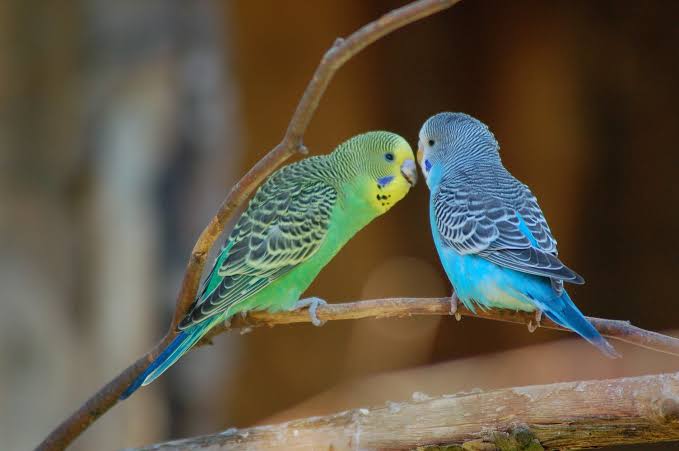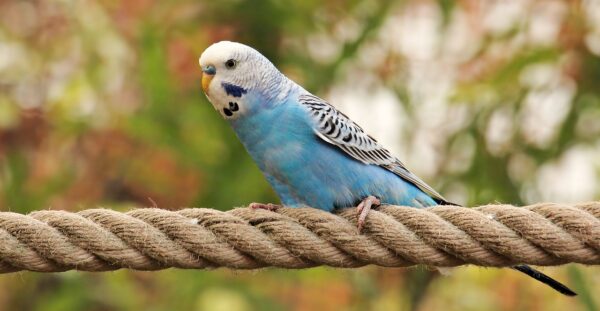The budgie is most popular birds as a pet in the world. These are the number one pet birds in the world, but if we talk about pets, they come after dogs and cats.
This bird is affectionate, cute, small and cheap. If trained properly they can imitate human speech very well.
They are Commonly known as the budgerigar, this small bird is a charming companion for most pet owners.

Budgerigars Species Overview
Scientific name: Melopsittacus undulatus
Size: 7 to 8 inches
Weight: 30 to 40 grams
Wingspan: 12 inches
Lifespan: 5 to 8 years in captivity
Diet: OmnivoreTalking
Abilities: Can talk and mimic human speech
Habitat: Open woodland and grassland near water
Contents
- 1 All Budgies Are Parakeets, But Not All Parakeets Are Budgies
- 2 These are mainly of two different types of budgerigar
- 3 They are one of the smallest true parrot species
- 4 Green Is the Only Natural Color for Budgies
- 5 Budgerigar’s Origin and Natural Habitat
- 6 Budgies may learn to talk better than some larger parrots
- 7 How fast do Budgrigars fly?
- 8 Do Budgerigars migrate?
- 9 How many eggs do they lay?
- 10 Budgerigar Personality and Behavior
- 11 Budgerigars’ Mating and Reproduction
- 12 Predators and threats to budgerigars
- 13 Where to Find Budgerigars
- 14 How much does a buggy cost?
- 15 Why are budgies so cheap?
- 16 Budgerigars Care Tips – How to Raise These Birds
- 17 Do budgies poop a lot?
- 18 Common Health Issues of Budgerigars
- 19 Cage Requirements
- 20 FAQ
- 20.1 Can I wash my budgie?
- 20.2 What does it mean when your budgie keeps chirping?
- 20.3 What should you not do with a Budgie?
- 20.4 Are budgies hard to care for?
- 20.5 Is a Budgie a good pet?
- 20.6 Do Budgies recognize their owners?
- 20.7 Are Budgies loud at night?
- 20.8 How long does a Budgie live?
- 20.9 Are Budgies smelly?
- 21 Conclusion
All Budgies Are Parakeets, But Not All Parakeets Are Budgies
Budgies are known by their full name budgerigar, but in America, they are known as parakeets.
Budgies are parakeets, and there are many different types of parakeets. Some parrots, such as Indian ringneck parakeets, are very large, reaching up to 16 inches in length, while budgies are much smaller parakeets. If you want to know more about the difference between the two then read our other article Parakeet vs Budgie.
Because of these differences in size, these birds are more commonly known by their actual names.
These are mainly of two different types of budgerigar
What many people don’t know is that there are actually two different types of budgies – the traditional budgerigar, which is found primarily in Australia and the larger English Budgie, commonly found in England, which is bred for the pet bird trade.
Although it is not easy to differentiate between the two when they are separate, when they are seen together the difference is clearly felt.
English budgies are typically 1 to 2 inches taller than their Australian counterparts and have larger heads and fluffier feathers around the face and crown.

They are one of the smallest true parrot species
Budgies are not the smallest parrots but they are quite small. The average length of budgies is usually between 7 and 8 inches. Budgies, native to Australia, are even smaller.
Green Is the Only Natural Color for Budgies
People have commonly seen a variety of coloured budgies for sale in pet stores, but the only natural colour of budgies seen in the wild is yellow/green.
The blue budgie, including the white budgie and all other coloured budgies, are color mutations bred specifically for the pet trade.
There is nothing different about these birds, apart from their colours, but in the forest, you can see only the blue budgie.
Budgerigar’s Origin and Natural Habitat
budgerigars inhabit the interior west of Australia’s Great Dividing Range. On average they can range from 3 to 100 birds in a flock, but after the rainy season, their flocks can reach thousands!
These birds always prefer to live in savannas, grasslands, open forests and grassy forests. Since they need to drink water every day, they are often seen near water.
Budgies may learn to talk better than some larger parrots
There is no way to guarantee that any parrot will learn to speak. However, budgies certainly have a natural ability for this, and there are many budgies that, given proper training, can learn to speak with good clarity and vocabulary compared to larger parrot species such as macaws and cockatoos.
Although their voice is husky, Budgie also has the ability to understand human words and phrases and sometimes use them in the proper context. These parrots are better for people looking for a talking parrot as a pet.
How fast do Budgrigars fly?
Budgerigar fly at different speeds. When migrating or flying in the open sky they can fly at a maximum speed of 22 mph. But sometimes, their speed slows down to 11 mph to increase manoeuvrability.
Do Budgerigars migrate?
Budgerigar are native birds of Australia. They always migrate from the northern part of Australia to the southern part and then back again.
In the north of Australia, they reside in the north when the summer season is from December to March and move south when temperatures drop from March to August.
How many eggs do they lay?
Female budgerigars can lay 6 to 8 eggs twice a year. In the forests of northern Australia, their breeding season usually occurs between June and September. But if they migrate south, this also happens from August to September.
Budgerigar Personality and Behavior
Budgies are very courageous, friendly and social birds. When not migrating they prefer to form pairs or live in small colonies in the wild.
Whether they are resting or hunting, they alert each other to danger by using their distinctive ‘chirping’ sounds. Even in captivity, the budgerigar is playful and friendly.
Budgerigars’ Mating and Reproduction
Budgies are monogamous and loyal to their partner, and they stay with their partner for life. Their breeding season can occur at any time, but it often occurs after the rainy season.
Their nests are often built from existing cavities in tree trunks, logs, branches and old fence posts. Female budgies reach maturity when they are eight months old.
They lay about 4 to 8 eggs at a time and incubate them for 18 to 20 days. Since chicks cannot see at birth and do not have feathers, their mothers need to keep them warm until their eyes open or longer.
Their father, on the other hand, is responsible for providing fodder and feeding the chicks. After six to eight weeks of age, the chicks can begin to learn to fly and attempt to fly out of the nest.
Predators and threats to budgerigars
Wild budgerigars often suffer devastating attacks from hawks and eagles. Since they are small they are easy prey even for wild cats. Sometimes, rodents attack budgie nests for eggs and even prey on the birds!
Where to Find Budgerigars
Being native to Australia, these budgies exist in large numbers. But what would it be like to raise a budgie in America?
Well, you can find many budgies in pet stores. But sadly, these are not natural but are mainly products of the breeding process.
You may also adopt rescued budgies at adoption centres or parrot rescue organizations.
Birds from these organizations are required to undergo the following medical tests:
- Micro fecal analysis (to ensure parasite-freeness of the bird)
- Testing for Chlamydophila psittaci (parrot fever)
- General blood testtesting for other diseases
How much does a buggy cost?
The cost of a budgerigar ranges from about $10 to $35. It depends on where you buy it, from a breeder or a pet store.
Why are budgies so cheap?
Unlike larger parrots, breeding of these birds is very easy and cheap. That is why breeders sell this breed at a low price and that is why they are so affordable.
Additionally, some large breeders recklessly breed countless budgies without any concern for the health or temperament of the adults or chicks of these birds.
This is a sad reality and one of the reasons budgerigars are more affordable and cheap than other birds.
Budgerigars Care Tips – How to Raise These Birds
Budgerigar Diet and Nutrition
Budgies drink a lot of water, especially in the morning. Their water consumption can be up to 5.5% of their body weight per day, so they need to be provided with clean water every day.
Budgies usually eat grass seeds, grains and nuts in the forest. Seeds are not enough for these birds, so their diet should include the following:
- pellets
- fresh fruits
- vegetables like leafy greens
- small amount of seeds
Do budgies poop a lot?
Budgies defecate about three or four times per hour and at least 40 to 50 times a day. They still poop when they’re sleeping, but not as much as during the day.
Common Health Issues of Budgerigars
- Tumors
- Megabacteria
- Goiter
- Brown hypertrophy of the cere
- Psittacosis or parrot fever
- Psittacine beak and feather disease
- Cnemodocoptes mites
- Polyomavirus
- Liver disease
Cage Requirements
The minimum cage size required for a budgie is 12x18x18 inches. It would be best if your bird spent most of its time outside.
But if you will keep them caged most of the time, you should keep them in a larger cage, which will give them enough space to fly and play.
What a budgie needs in its cage?
- perches
- feeding and drinking bowls
- something to chew
- a swing
- some toys
- bird bath
- sand sheets or loose sand that will serve as a substrate for the bottom of their cage
How often should you clean the budgie cage?
Clean budgie cages thoroughly with non-toxic disinfectant soap and warm water at least once a week.
It is also important things to clean and hygiene everything in the cage, including plastic toys, bowls, and the bottom tray.
FAQ
Can I wash my budgie?
Most budgies love baths, so they will be happy if you bathe them several times a week.
What does it mean when your budgie keeps chirping?
Budgies chirp when they are happy. They also chirp when they connect and communicate with their herd.
What should you not do with a Budgie?
Things like scented candles, perfume, aerosol sprays and air fresheners are poisonous to these birds, so avoid using these items when they are around.
Are budgies hard to care for?
Budgerigars are easy and inexpensive to care for because they have low maintenance costs. This is why they are excellent “beginner birds” according to many pet bird owners.
Is a Budgie a good pet?
Budgies can make good pets because they are friendly, low-maintenance, gentle, and affectionate in nature. In fact, they are the most common household pets after dogs and cats.
Do Budgies recognize their owners?
Even if budgies are separated from their owners for long periods of time, they still recognise their owner’s voice and facial expressions. They also show affection by flying toward their owner and resting on his or her shoulder.
Are Budgies loud at night?
Budgies do not make loud noises at night because most budgies like to sleep at night. They will stop making noise when it gets dark, for example, when there is no daylight or the lights are off.
How long does a Budgie live?
The lifespan of budgerigars can range from 7 to 15 years.
Are Budgies smelly?
These birds never produce their own smell, that is, there is no smell in their body. But just as if someone does not take a bath, his body starts smelling, so is this also.
Conclusion
Many beginner pet bird owners choose to keep this bird species to begin their journey into the world of birds.
These birds are social and intelligent and also famous for their beautiful vivid plumage. Plus, they are very easy to raise and train.
So, the buggies are really worth the price. But before you buy your first budgerigar bird, make sure you are buying it from a good and reputable breeder.
